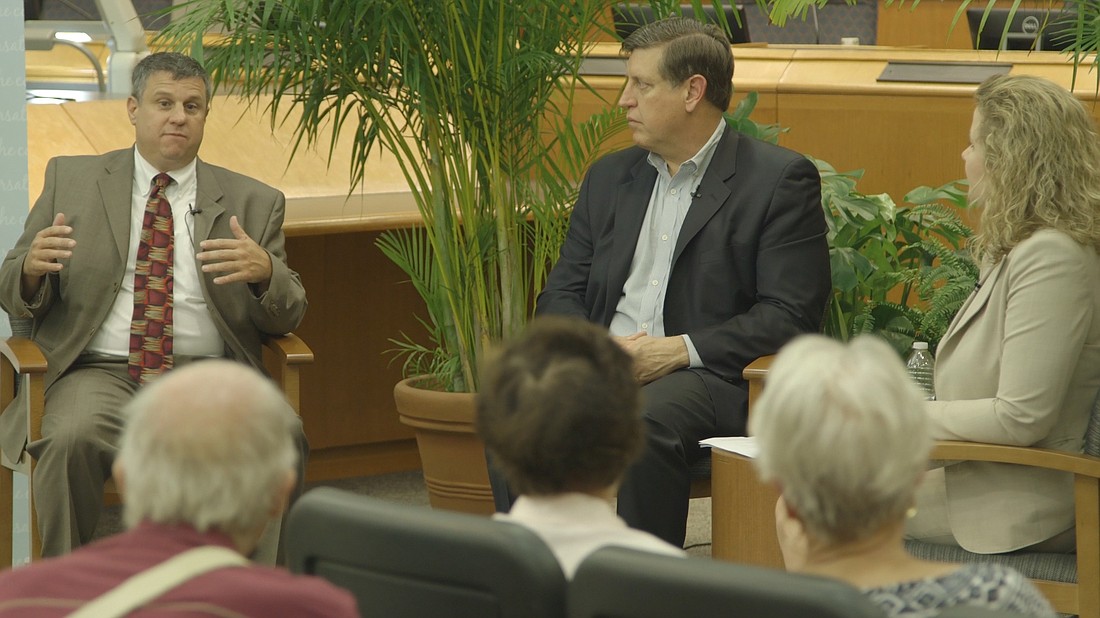- April 19, 2024
-
-
Loading

Loading

Now more than a year removed from a failed joint effort to pursue a regional come-as-you-are homeless shelter, the Sarasota County and City commissions will meet Nov. 6 to discuss regional homeless strategies.
Although members of each board hope to find common goals, City Commissioner Susan Chapman isn’t optimistic that the time apart will bear fruitful results.
“I would love to find a way to stop this circular argument, I really would — but I have no idea how to do it,” Chapman said at a meeting Monday. “We have been saying the same things for what? Over a year, a year and half, at least? There’s just a fundamental, fixed difference.”
Indeed, the city and the county have focused on distinct plans for addressing homelessness. The county has continued to follow the guidance of Robert Marbut, the consultant originally hired by the city and county and the man behind the 250-bed come-as-you-are shelter proposal. The county has been satisfied with Marbut’s work addressing non-chronic homelessness issues.
The city has pivoted after abandoning the shelter talks, pursuing a “housing first” model. This plan aims to place homeless individuals in permanent supportive housing as quickly as possible. Supporters say this has become the favored approach across the country: A report from the U.S. Interagency Council on Homelessness says “the research is overwhelmingly clear” that housing first is the solution for chronic homelessness.
City Manager Tom Barwin has downplayed the split, pointing to the city and county’s shared interest in some sort of shelter — but even that point of agreement is the source of discord.
The county would like a shelter within city limits, close to existing service agencies and the jail. The city believes such a facility would disproportionately burden the surrounding neighborhood. The county is interested in a shelter as a jail diversion program; the city sees it as a checkpoint before individuals can be housed. The ideal size differs, too.
“We adopted a plan for a shelter — a navigation center with 25 to 50 beds,” Barwin said. “In staff conversations with the county, they’re responding that they’re continuing to tick with the 250-bed project. There are different perspectives, different needs.”
"There are different perspectives, different needs." — Tom Barwin
City commissioners asked to invite the county’s other municipalities to the Nov. 6 meeting, partially out of concern that the dialogue might not be productive otherwise. They’ve also asked staff to obtain more substantive data regarding their plans for the county.
Although she is an advocate for housing first, City Commissioner Shelli Freeland Eddie sees room for collaboration. She recognizes there’s a chance the two sides determine their positions are incompatible, but she believes the city and county owe it to their constituencies to at least try.
Eddie frustrated with the lack of implementation all around. She wants the joint meeting to focus on items the city and county can actually act on, including a discussion of logistics and cost. She hopes it serves as a first step toward a more substantive strategy to address homelessness.
“We’re not going to have all the answers, but at least we’ll have a starting point — and it has to be beyond do we or don’t we want the shelter,” Eddie said. “What are some immediate needs? How can our priorities come together to achieve those needs and what are the resources available? “
Among county officials, there is a broader consensus that a joint meeting will be productive. County Director of Homeless Services Wayne Applebee sums up the county's viewpoint: It’s not opposed to housing first, but does believe it can't address the homeless issue alone.
“It’s about developing a coordinated, collaborative system where we might take different pieces of the pie,” Applebee said. “If we can get to that discussion, we might have some success.”
"We typically funds parts of systems. We don’t fund entire systems from A to Z." — Wayne Applebee
That separate-but-together philosophy might continue into the funding stage, too. Applebee said the county currently focuses on funding crisis programming, teaming with other partners that provide longer-term care.
“I think the county certainly understands the need for housing,” Applebee said. “At the same time, we typically funds parts of systems. We don’t fund entire systems from A to Z.”
For Chapman, perhaps the strongest critic of the Marbut proposal, she still doesn't think there's been enough evidence to support the efficacy of the come-as-you-are shelter. In that respect, compromising and allowing the county to build it holds less appeal. She'd rather make the case to the county that housing first is the right goal to prioritize, but she's skeptical that the city will have the opportunity.
“I would love to have an opening for that, but it doesn’t seem to be coming,” Chapman said. “I would like to find a way to resolve it other than — we have to do what they say, which is not the mainstream approach anymore.”